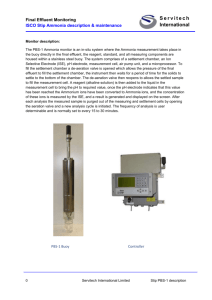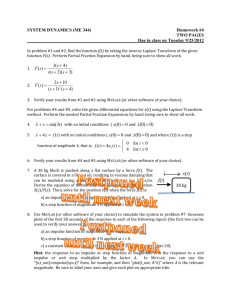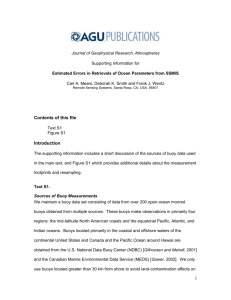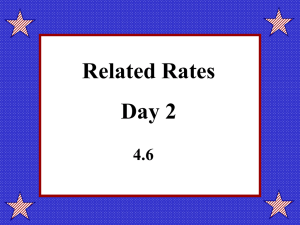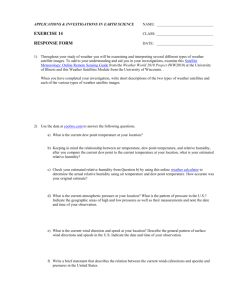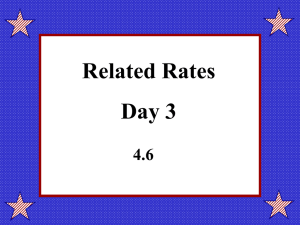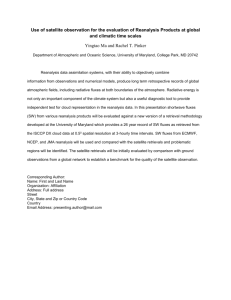lknrlgeklgkglkirghlkehrlgkhsdfl - cbmet.com
advertisement
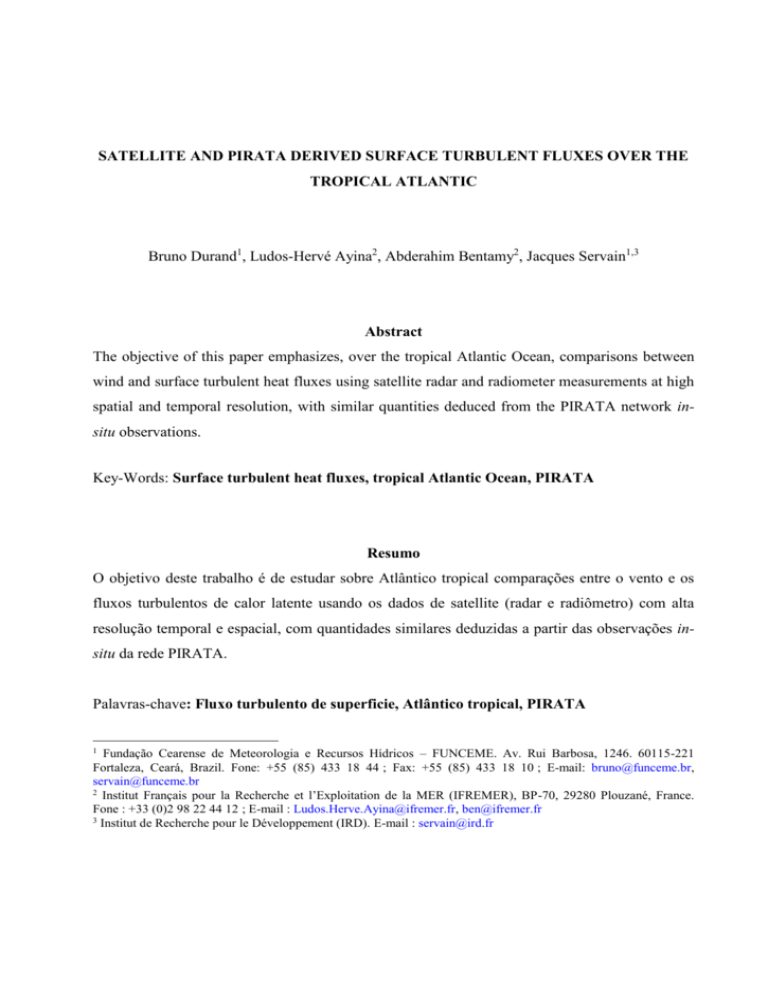
SATELLITE AND PIRATA DERIVED SURFACE TURBULENT FLUXES OVER THE TROPICAL ATLANTIC Bruno Durand1, Ludos-Hervé Ayina2, Abderahim Bentamy2, Jacques Servain1,3 Abstract The objective of this paper emphasizes, over the tropical Atlantic Ocean, comparisons between wind and surface turbulent heat fluxes using satellite radar and radiometer measurements at high spatial and temporal resolution, with similar quantities deduced from the PIRATA network insitu observations. Key-Words: Surface turbulent heat fluxes, tropical Atlantic Ocean, PIRATA Resumo O objetivo deste trabalho é de estudar sobre Atlântico tropical comparações entre o vento e os fluxos turbulentos de calor latente usando os dados de satellite (radar e radiômetro) com alta resolução temporal e espacial, com quantidades similares deduzidas a partir das observações insitu da rede PIRATA. Palavras-chave: Fluxo turbulento de superficie, Atlântico tropical, PIRATA Fundação Cearense de Meteorologia e Recursos Hídricos – FUNCEME. Av. Rui Barbosa, 1246. 60115-221 Fortaleza, Ceará, Brazil. Fone: +55 (85) 433 18 44 ; Fax: +55 (85) 433 18 10 ; E-mail: bruno@funceme.br, servain@funceme.br 2 Institut Français pour la Recherche et l’Exploitation de la MER (IFREMER), BP-70, 29280 Plouzané, France. Fone : +33 (0)2 98 22 44 12 ; E-mail : Ludos.Herve.Ayina@ifremer.fr, ben@ifremer.fr 3 Institut de Recherche pour le Développement (IRD). E-mail : servain@ird.fr 1 INTRODUCTION Surface fluxes of momentum, heat, and water vapor provide some of the dominant processes responsible for climate variability. Estimates of the surface fluxes, whether they use in-situ, numerical analysis, or satellite data, usually rely on the bulk formulae that parameterize the fluxes in terms of the observed mean quantities. In the past, the various surface flux atlases have used different versions of the bulk formulae and, as a result, the estimated fluxes vary significantly from one atlas to another. In this project, we ensure that the bulk flux estimate formulas are consistent. All the turbulent surface fluxes depend on the surface wind, whose importance for the goals of our study cannot be overly stressed. This paper investigates the accuracy of surface winds and latent heat flux retrieved from satellite measurements over the tropical Atlantic ocean. The scatterometer onboard the European Remote Sensing satellite (ERS-2) and the SeaWinds scatterometer on NASA satellite QuikScat are used to estimate surface winds in terms of wind speeds and directions. The scatterometer winds are used in combination with sea surface temperature (SST) from the Advanced Very High Resolution Radiometer (AVHRR) and atmospheric humidity measurements from the Special Sensor Microwave/Imager (SSM/I) on board DMSP satellites F10, F11, F13, and F14 (Bentamy et al, 2003). The use of data from several satellites allows enough sampling to construct daily and weekly wind and evaporation rate estimates. The accuracy of the resulting winds and latent heat flux estimates is determined by comparison with buoy estimates. In this study, the buoy PIRATA network (Servain et al., 1998), located in the tropical Atlantic Ocean, is used. PIRATA buoy measurements are described in http://www.brest.ird.fr/pirata/infos_fr.html. Briefly, their systems measure hourly surface vector wind, air temperature, SST, relative humidity, solar radiation, and subsurface water temperatures at several depths. Wind is measured at a height of 4 m above the sea surface using an RM Young propoller-van sensor which is sampled at 2 Hz and vector averaged for 6 min. Air temperature is measured with resolution of 0.04°C by a linearized thermistor mounted in a baffled housing to reduce the effects of solar heating. Sensors for the air temperature and relative humidity are installed at 3 m above the sea surface. SST is measured at 1 m depth to a resolution of 0.002°C. The air temperature, SST, and relative humidity sensors sample every 10 min and the averaged hourly the six observations. However, data available on PIRATA Web site are daily averaged. The latter are used in this study. For comparison with remotely sensed winds and latent heat fluxes, the Liu-KatsarosBusinger (LKB) model (Liu et al. 1979) is used to calculate 10 m wind speeds and humidity (when measured) at neutral conditions. REMOTELY SENSED WIND ACCURACY Figure1 shows scatterplots of the comparison of the weekly winds estimated from ERS-2 scatterometer wind observations versus weekly averaged buoy winds during the period 1997 – 2001. the two data sets compare well. For instance, the overall wind speed bias, rms difference, correlation coefficient and symmetrical regression coefficients are 0.38 m/s, 0.72 m/s, 0.92, and 0.98 respectively. For wind direction, no systematic bias is depicted, and the overall bias, standard deviation, and vector correlation are about 9°, 17°, and 1.13, respectively; Similar comparisons were performed between daily winds, calculated from QuikScat scatterometer observations, and buoy daily averaged wind vectors. Figure 3.2 illustrates such comparisons. It indicates that remotely sensed wind speed, zonal component, meridional component, wind direction exhibit good agreement with PIRATA buoy daily data. The overall wind speed bias, rms difference, correlation coefficient, and symmetrical regression are about – 0.52 m/s, 1.66 m/s, 0.84, and 1.06. For wind direction the mean difference is low. The corresponding standard deviation is about 27°. The highest discrepancy is found for buoy wind speed less than 3 m/s. This may be related to rain impact on backscatter coefficient. Table 1 summarizes the main statistical parameters characterizing buoy and scatterometer wind comparisons. Wind Speed Wind Direction (m/s) (deg) Buoy Location Length X X as r D D 2 (days) 10°S 10°W 790 -0.07 1.00 1.07 0.79 0 9 0.60 0°N 10°W 389 -0.03 1.30 0.90 0.68 2 17 0.37 15°N 38°W 839 -0.30 1.45 1.03 0.81 -3 15 1.00 8°N 38°W 868 -1.21 2.33 0.78 0.77 -1 25 0.98 0°N 35°W 931 -0.62 1.61 0.77 0.78 0 19 0.86 12°N 38°W 918 -0.58 1.76 0.86 0.78 -4 21 0.84 4°N 38°W 860 -1.14 2.09 0.86 0.75 -6 22 1.06 0°N 23°W 1015 -0.33 1.52 0.82 0.75 2 22 0.80 0°N 0°E 326 -0.46 1.61 0.99 0.61 -10 30 0.20 6°S 10°W 612 -0.04 0.99 1.00 0.79 2 10 0.76 2°N 10°W 114 -0.74 1.90 0.90 0.62 -8 28 0.38 2°S 10°W 118 -0.21 1.03 0.81 0.78 -2 12 0.59 Table 1: Statistical parameters characterizing the difference between PIRATA and satellite winds LATENT HEAT FLUX ACCURACY The latent heat flux is generally described by the following bulk aerodynamic formula that is suitable for available satellite or in-situ surface observations: QE L CE U a U 0 qa qs (1) Where L is the latent heat of evaporation; is the air density; qa is the mean specific humidity at a fixed height near the surface; CE is the bulk transfer coefficient for water vapor (also known as Dalton number), U a is the wind near the surface at a height of typically 10 m, U 0 is the surface speed or current usually set to 0, and q s is the mean specific humidity just above the airsea interface. The calculation of QE using (1) implies the knowledge of three key parameters: (1) Surface wind speed at 10-m height (U10). U10 is derived from ERS-2, NSCAT, and SSM/I observations. Note that the remotely sensed surface winds are estimated for neutral conditions. (2) SST is derived from the AVHRR onboard NOAA satellites. For this study, the daily optimally interpolated SST data calculated by the Reynolds and Smith (1994) at NCEP are used. (3) Surface air humidity (qa) is estimated from brightness temperatures measured by SSM/I (Bentamy et al, 2003). The weekly satellite-derived latent heat fluxes are compared with weekly averaged buoy observations. The 10 m buoy wind speeds are estimated for neutral conditions. The buoy specific air humidity is derived from the buoy specific saturation humidity (using buoy SST and air temperature), and relative humidity. The bulk transfer coefficient uses same parameterization that satellite. It is a function of buoy U10. Therefore, buoy measurements allow the estimation of daily buoy latent fluxes. For comparison purposes, the weekly averaged buoy data are calculated under the condition that for each week at least 4 day estimates are available. During the period September 1997 through January 2001, satellite and buoys exhibit similar statistical parameters of latent heat flux. There are 272 collocated weekly data pairs of PIRATA-satellite latent heat flux estimates. The latent heat flux derived from PIRATA measurements is mainly ranged between 25 W/m2 and 350 W/m2, with a mean value of 115 W/m2 and a standard deviation of 42 W/m2. The overall mean and rms difference between buoy and satellite latent heat flux estimates is 1 W/m2 and 24 W/m2, respectively. Such statistics are quite similar to those obtained from TAO and satellite comparisons (Bentamy et al, 2003). Figure 2 provides an example of satellite/buoy time series comparisons at three PIRATA buoy locations, corresponding to the longest time series of weekly-averaged buoy latent heat fluxes. The correlation coefficients, exceeding 0.79, indicate good agreement between satellite and buoy QE estimates. Most weekly buoy QE variations are also exhibited by the satellite estimates. Fig. 1: Comparison of the weekly wind speeds, zonal components, meridional components, and wind directions calculated from ERS scatterometer observations with 10 m weekly averaged PIRATA buoy winds Fig. 2: Time series of calculated latent heat flux from three PIRATA buoys (red) located at 15°N-38°W (a), 12°N-38°W (b), and 0°N-35°W (c), and calculated from merging satellite observations (black) REFERENCES Bentamy A., K B. Katsaros, M. Alberto, W. M. Drennan, E. B. Forde, and H. Roquet, 2003 :Satellite Estimates of wind speed and latent heat flux over the global oceans, J. Climate, 16, 637 - 656 Liu, W. T., K. B. Katsaros, and J. A. Businger, 1979: Bulk parameterization of air-sea exchanges of heat and water vapor including the molecular constraints at the interface. J. Atmos. Sci., 36, 1722-1735. Reynolds, R.W., and T.M. Smith, 1994. Improved global sea surface temperature analyses using optimum interpolation. J. Climate, 7 (6), 929-948. Servain, J., A. J. Busalacchi, M. J. McPhaden, A. D. Moura, G. Reverdin, M. Viana, S. E. Zebiak, 1998: A Pilot Moored Array in the Tropical Atlantic (PIRATA). Bull. Amer. Meteor. Soc, 79, 2019-2031.
